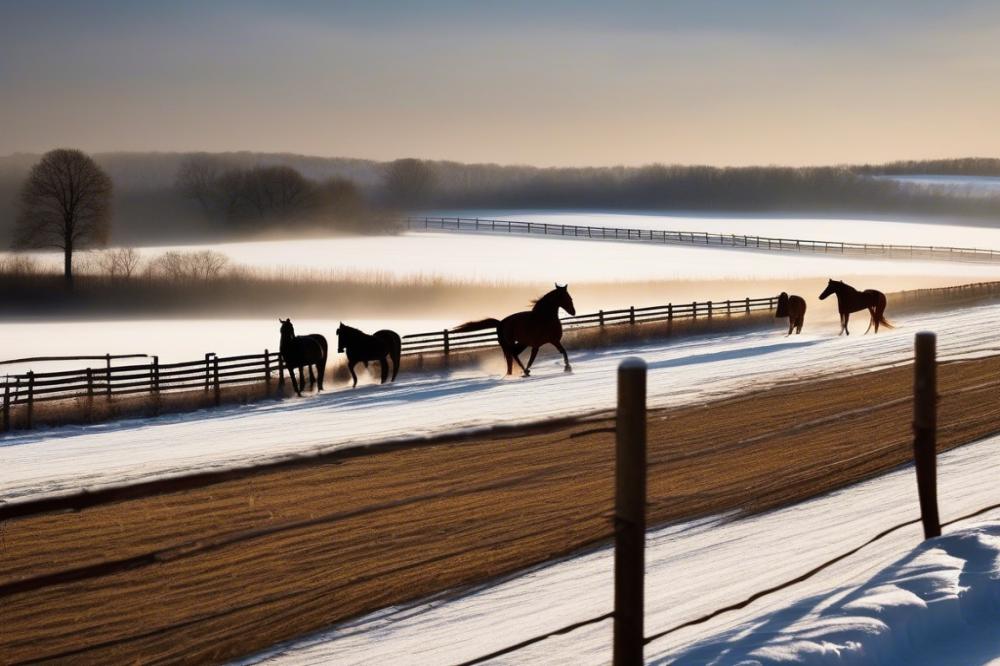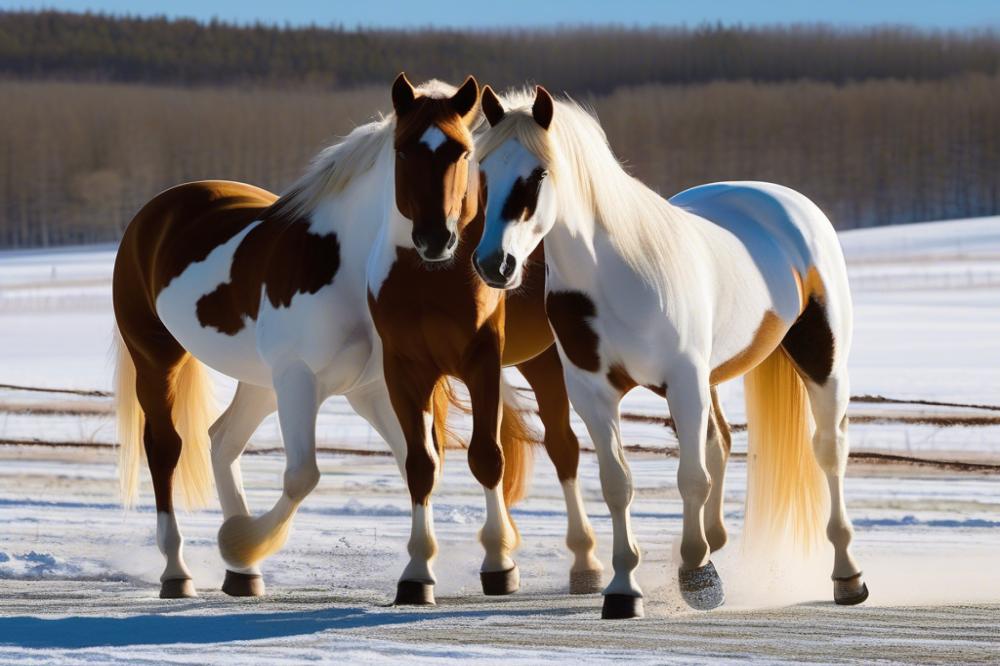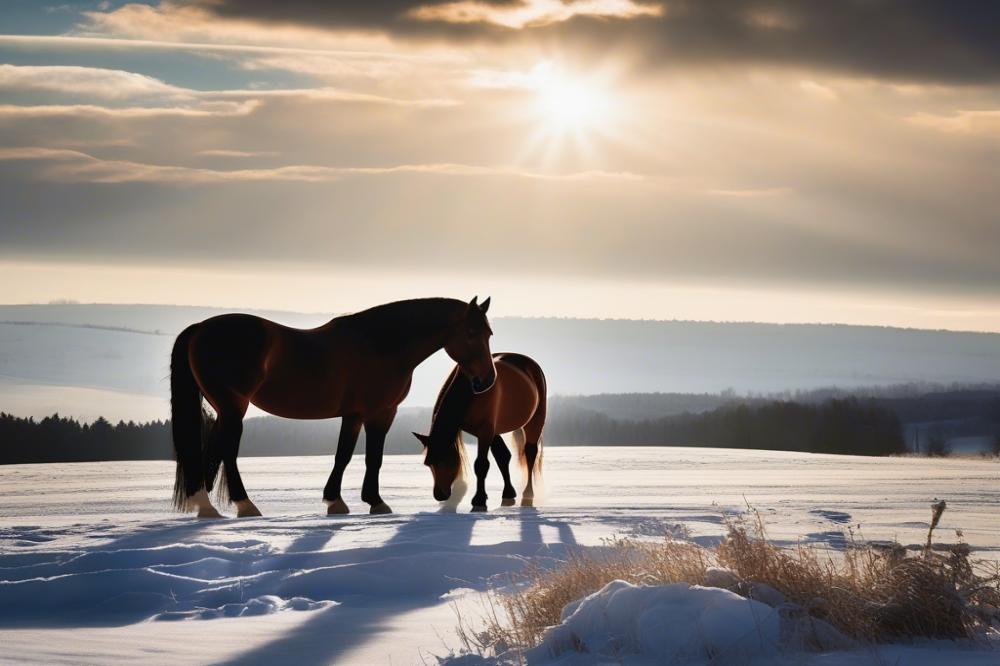Introduction
In the realm of animal physiology, the mechanisms by which creatures maintain homeostasis are as fascinating as they are complex. This is particularly evident in large mammals such as horses“>horses, which possess remarkable adaptations for regulating core temperature in extreme climatic conditions. Throughout searing summers or frigid winters, these majestic beings exhibit a range of physiological responses that allow them to withstand severe environmental stressors. The processes involved in body temperature regulation offer insight into their resilience and survival strategies.
Understanding how these animals cope with the harshness of varied temperatures requires a blend of scientific inquiry and observational learning. Through a unique combination of behavioral and physiological adaptations, they manage to create a balance that promotes their health and vitality. As we delve deeper into this subject, it becomes clear that the mechanisms at play are intuitive yet intricate, reflecting the evolution of these creatures over millennia.
Various factors contribute to their ability to maintain optimal functioning. Sweating, changes in blood flow, and even alterations in behavior such as seeking shade or shelter all play significant roles. When temperatures plummet, these mammals instinctively seek out warmth, layering themselves in natural insulation that the environment provides.
Each response is a testament to their evolutionary heritage, highlighting the interconnectedness of environment and survival. Through this exploration, we aim to illuminate not only the specifics of their thermoregulation strategies but also the broader implications for animal welfare and care practices. Engaging with these insights paints a vivid picture of a life lived in harmony with nature’s extremes.
Horses and thermoregulation

Thermoregulation serves as a critical process for maintaining stable body temperatures in varied climates. Animals utilize several methods to cope with temperature fluctuations. Metabolic activity plays a major role in this delicate balance. As they move and work, heat is generated within their bodies. This internal heat, if not managed well, can lead to overheating.
Cooling off requires a multi-faceted approach. Sweating emerges as one of the most effective strategies. It’s nature’s air conditioner, allowing the body to release heat through evaporation. When sweat droplets evaporate from the skin, they carry heat away. This natural phenomenon showcases the efficiency of cooling mechanisms. Even in extreme heat, a well-hydrated animal can sweat adequately and maintain its thermal equilibrium.
Water is another factor that cannot be overlooked. Staying hydrated does wonders for regulating temperature. Dehydration can hinder the ability to sweat. Imagine trying to run a marathon in the blazing sun without water; it would be nearly impossible! Maintaining proper hydration ensures efficient thermoregulation. Without sufficient fluids, metabolic processes struggle to function at their best, increasing the risk of heat stress.
Panting is another way to expel excess heat during high temperatures. It allows for rapid exchange of air, cooling blood circulating through the respiratory system. Under cold conditions, a different approach prevails. An increase in metabolic rate generates warmth, helping to retain core temperature. In winter months, adapting to chill often means growing a thicker coat, acting as a natural insulation layer. This adaptability reflects how well nature equips creatures for survival in diverse environments.
In extreme conditions, both hot and cold, behavior shifts as well. Seeking shade or engaging in resting activities during peak heat hours demonstrates innate wisdom. Conversely, huddling together for warmth shows instinctual behavior that has endured through the ages. Observing such traits reveals a remarkable synergy between physiology and behavior. Just like humans, those creatures have their own ways of coping with the heat waves and cold snaps.
Ultimately, understanding how these methods work highlights the exceptional balance that nature has achieved. Just like we relish a cool drink on a hot day, these animals thrive on the clever adaptations they’ve developed over many generations. The interplay between metabolism and behavior exemplifies the enduring quest for thermal stability.
Perspiration and Cooling Techniques

Mechanism of Perspiration in Horses
Imagine a summer day where the sun blazes down relentlessly. In such conditions, perspiration becomes the go-to mechanism for cooling. When the body temperature rises, glands in the skin produce sweat. This sweat is composed primarily of water, but it also contains salt and other electrolytes. As this liquid evaporates from the skin’s surface, it creates a cooling effect. This principle is quite similar to how humans cool down, although the process in equines can be slightly more efficient.
A thick coat may keep some of the heat in, but it also has its advantages. Fur traps a layer of air that can provide insulation, while perspiration works hard to keep the animal cool. When sweat begins to dry, it takes heat with it, allowing the body to return to equilibrium. The efficiency of this process varies with environmental factors.
Comparison of Perspiration with Other Cooling Techniques
While sweat is a primary cooling mechanism, it is not the only option available. Horses also engage in behavior that helps manage body temperature. Shade-seeking is a common tactic. Finding a cool spot under the trees can offer relief from the scorching sun. Water play is another enjoyable avenue; splashing around can be quite refreshing.
Deep breathing aids in cooling as well. Increased respiration allows airflow to help dissipate heat. Unlike perspiration, which is entirely dependent on evaporation, these methods can provide immediate comfort. However, when it comes to long-term temperature regulation, perspiration reigns supreme.
Effects of Humidity on Perspiration Efficiency
Humidity plays an enormous role in how well perspiration works. When air is saturated with moisture, sweat does not evaporate as effectively. Think of trying to dry a wet towel on a rainy day; it just won’t happen. In humid conditions, perspiration may actually lead to overheating.
Heat stress is a genuine concern during humid weather. When sweat cannot escape, the body’s internal mechanisms struggle to cool down. The implications are significant. Reduced performance and increased risk of heat-related illnesses become a reality. Resting in front of a fan may seem logical to some, but nature doesn’t always offer such luxury. Equines are particularly susceptible, and they require attentive care in sticky situations.
Monitoring conditions can be vital, especially during the sweltering summer months. One metaphorical friend wouldn’t leave his dog outside on a hot day. Just like that, a keen observer should make sure that equines don’t suffer when it gets sweltering. Environmental awareness plays a crucial role in effective temperature regulation.
Coat Insulation and Adaptations to extreme weather

In the wild, the coat acts as a remarkable insulator for various equine breeds. Fibers in the coat trap heat, providing a barrier against frigid temperatures. Each breed comes with its own set of characteristics, reflecting the climates they have adapted to over generations. For instance, the thick manes and woolly undercoats of some northern breeds are nature’s way of offering robust protection against the harsh chill. Conversely, others thrive in milder surroundings, sporting sleeker coats that are less dense and tailored to warmth without overheating.
Seasonal changes make a significant difference in how these animals cope with their environment. In autumn, many equines begin to grow their winter coats, which is like putting on a cozy sweater. The transition helps to prepare them for colder months. When spring arrives, shedding begins, allowing them to adapt to rising temperatures. This fascinating process serves not just a functional purpose but also enhances comfort as they navigate shifting weather conditions.
A variety of factors plays a role in how coat length and density influence temperature control. Longer, denser hair can act like a down jacket, providing additional warmth. However, excessive length may interfere with evaporative cooling. In contrast, a shorter coat can lead to overheating in warmer climates. The body becomes a furnace when trapped heat from exercise combines with warm air. Strike the right balance between coat length and climate, and one can achieve optimal thermal regulation.
Behavioral Adaptations to Maintain Temperature
How horses seek shelter during extreme weather
When the sun blazes or the snow falls, their instincts kick in. Seeking refuge from the elements becomes paramount. Wooded areas or dense brush provide much-needed cover. The shade of a majestic tree can feel like an oasis in a desert. In winter, they gravitate towards natural windbreaks, such as hills or planted hedges, which soften the biting chill. Observing these creatures in action often reveals their insightful choices. A group of them huddling together under a canopy of leaves is a relief, for both warmth and protection. Horses exhibit a keen awareness of their surroundings. They seem to know exactly where to go when conditions turn treacherous.
Social behavior and group dynamics in temperature regulation
In times of extreme weather, social ties become stronger. Animals naturally band together to create a warmth that solitary beings can rarely achieve. Flocking helps them maintain body temperature, especially in chilly climates. It’s a sight, really, seeing them bunch together, forming a living blanket against the elements. Leaders emerge within the herd, indicating where to go and when to seek shelter. These dynamics are not just vital for survival; they offer companionship too, easing anxiety in stressful situations. Who would want to be alone in a storm, anyway? The social structures established among these animals are essential in creating a microclimate that serves to better regulate warmth.
Natural instincts in finding shade or water
Finding shade is as crucial as locating fresh water when temperatures soar. With an innate sense, they gravitate towards the shadowy side of barns or structures. Natural instincts guide them to areas with cooler ground. A patch of grass might seem simple, yet it harbors immense comfort during hot afternoons. Water sources are equally important; a quick dip or splash can significantly cool them down. Their seeking behavior is almost comical, darting towards a trough as if they were racing to a finish line. It is fascinating how their methods reflect a blend of practicality and instinct. Just like us, they seek the simplest solutions for comfort. Through these actions, they demonstrate resilience, adapting and thriving even under extreme circumstances.
Heat Stress and Its Management
Heat stress occurs when an animal cannot dissipate heat effectively, leading to an increased internal temperature. Symptoms in equines can range from excessive sweating to rapid breathing. You might notice a horse standing with its head drooped, staring blankly into space. In severe cases, it can lead to serious complications, including collapse. Observing these signs is crucial for timely intervention.
Preventing heat stress requires proactive measures. Providing ample shade is essential. Horses can seek refuge from the blazing sun beneath trees or structures. Access to fresh water should be constant and abundant, encouraging hydration. Fans or misters can also help circulate cool air in stable environments. Scheduling exercise during the cooler parts of the day can significantly mitigate the risk. Late mornings and early evenings typically present better conditions. Remember, just because it’s cooler doesn’t mean it’s safe.
A keen eye for monitoring these animals is vital. In extreme weather conditions, one cannot overlook subtle changes in behavior. A horse that usually gallops may suddenly appear lethargic. Collected data on heart rates and respiratory rates can provide insight into their well-being. Engaging regularly with your horse fosters a trusting relationship, making it easier to spot these anomalies. A watchful eye can be the difference between a carefree day and a health crisis.
Lastly, take note of the environment. Everything from humidity levels to direct sunlight can affect how animals cope with extreme temperatures. Each creature has its quirks. While some thrive in sunny patches, others prefer the cooler, shaded spots. Paying attention to these idiosyncrasies can help anticipate their needs.
A Lasting Impression
Understanding how equine creatures adapt to environmental challenges paints a fascinating picture of their biology. Amid the sweltering rays of summer or the biting chill of winter, these animals exhibit remarkable resilience. Adaptive mechanisms, such as sweating and shivering, allow them to thrive in harsh conditions. Just as a well-tuned engine operates efficiently under pressure, so too do these magnificent beings exhibit extraordinary physiological responses.
The coat serves as a remarkable insulator. During winter months, a thick, shaggy exterior traps warmth. In contrast, shedding this layer as the sun re-emerges highlights an intrinsic ability to respond aptly to changing conditions. When you see them in the field, there’s a quiet strength about their posture. It’s not just about survival; it’s about balance and harmony with their surroundings.
Moreover, hydration plays a vital role in how they cope. Access to fresh water is essential, as dehydration can disrupt their natural processes. Temperatures and bodies fluctuate, so maintaining proper hydration helps facilitate thermoregulation in equines. Nature equips them with skills to sweat, but this vital moisture also ensures that overheating does not become a significant risk.
Observation reveals a great deal about their behavior. Seeking shade under the boughs of a sprawling tree or standing in a brook, they instinctively know how to influence their environment. Every choice reflects an understanding of comfort and resource management. Looking at this dynamic can inspire deeper appreciation for these majestic animals.
Even in situations of extreme weather, they have an incredible capacity for adapting. The synergy of biology and environment manifests through intricate adaptations. Whether they’re galloping across a snow-covered field or lingering beneath the summer sun, their strategies remind us of the power of instinct.
If you wish to delve deeper into the intricacies of how creatures navigate the complexities of extreme weather, consider learning more about this topic. Explore further layers of their unique biology by signing up today. Check out your options and join a vibrant community of enthusiasts here.



